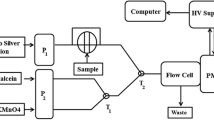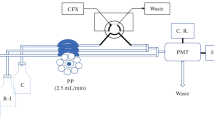Abstract
A sensitive and rapid flow-injection chemiluminescence (CL) method has been developed for the determination of gatifloxacin in pharmaceutical preparations and biological samples. The method is based on the enhancing effect of gatifloxacin on CL emission generated by the interaction of Ce (IV) in sulphuric acid and sodium hyposulphite (Na2S2O4) sensitized by sodium dodecyl benzene sulfonate (SDBS). Strong CL emission was observed when gatifloxacin was injected into the Ce (IV) in sulphuric acid and Na2S2O4 solution incorporated with SDBS in a flow-cell. Several experimental parameters affecting the CL reaction were investigated and optimized systematically. Under the optimum conditions, it was found that the CL intensity is proportional to the concentration of gatifloxacin in the range of 1.12 × 10−11–4.40 × 10−9 g mL−1 with a co-relation coefficient of 0.9994. The limit of detection was found to be 4.87 × 10−12 g mL−1 and the relative standard deviation (RSD, n = 7) was 1.8% for 4 × 10−8 g mL−1 of GFLX. The proposed method offers higher sensitivity, wide linear range and better stability without requiring sophisticated instrumentation. Thus, the proposed method has been successfully applied to the determination of gatifloxacin in pharmaceuticals, serum and human urine.





Similar content being viewed by others
References
Perry CM, Douglas O, Miriam H, Onrust SV (2002) Gatifloxacin: a review of its use in the management of bacterial infections. Drugs 62(1):169–207
Saravolatz LD, Leggett J (2003) Gatifloxacin, gemifloxacin, and moxifloxacin: the role of 3 newer fluoroquinolones. Clin Infect Dis 37:1210–1215
Grasela DM (2000) Clinical pharmacology of gatifloxacin, a new fluoroquinolone. Clin Infect Dis 31(Supp 2):S51–S58
Wei L, Chao W, Hong J (2009) Determination of gatifloxacin by spectrophotometric method with malachite green. Huaxue Shiji 31:191–193
Kshirsagar SJ, Chopade VV, Dhaneshwar SR (2008) A sensitive first and second derivative spectrophotometric method and validation for determination of gatifloxacin in bulk and pharmaceutical dosage forms. BioScan 3(2):147–150
Guo C, Dong P, Chu Z, Wang L, Jiang W (2008) Rapid determination of gatifloxacin in biological samples and pharmaceutical products using europium sensitized fluorescence spectrophotometry. Luminescence 23:7–13
Darwish IA, Sultan MA, Al-Arfaj HA (2010) Selective kinetic spectrophotometric method for determination of gatifloxacin based on formation of its N-vinyl chlorobenzoquinone derivative. Spectrochim Acta Part A 75(1):334–339
Amin AS, El-Fetouh Gouda AA, El-Sheikh R, Zahran F (2007) Spectrophotometric determination of gatifloxacin in pure form and in pharmaceutical formulation. Spectrochim Acta Part A 67(5):1306–1312
Guo C, Wang L, Hou Z, Jiang W, Sang L (2009) Micelle-enhanced and terbium-sensitized spectrofluorimetric determination of gatifloxacin and its interaction mechanism. Spectrochim Acta Part A 72(4):766–771
Zhu X, Gong A, Yu S (2008) Fluorescence probe enhanced spectrofluorimetric method for the determination of gatifloxacin in pharmaceutical formulations and biological fluids. Spectrochim Acta Part A 69(2):478–482
Ocana JA, Barragan FJ, Callejon M (2005) Spectrofluorimetric and micelle-enhanced spectrofluorimetric determination of gatifloxacin in human urine and serum. J Pharm Biomed Anal 37(2):327–332
Al-Dgither S, Alvi SN, Hammami MM (2006) Development and validation of an HPLC method for the determination of gatifloxacin stability in human plasma. J Pharm Biomed Anal 41(1):251–255
Overholser BR, Kays MB, Sowinski KM (2003) Determination of gatifloxacin in human serum and urine by high-performance liquid chromatography with ultraviolet detection. J Chromatogr B 798(1):167–173
Cavazos MLS, Gonzalez LYC, Lerma GG, Torres NW (2006) Determination of gatifloxacin in semen by HPLC with diode-array and fluorescence detection. Chromatographia 63(11–12):605–608
Nguyen HA, Grellet J, Ba BB, Quentin C, Saux MC (2004) Simultaneous determination of levofloxacin, gatifloxacin and moxifloxacin in serum by liquid chromatography with column switching. J Chromatogr B 810(1):77–83
Suhagia BN, Shah SA, Rathod IS, Patel HM, Shah DR, Marolia BP (2006) Determination of gatifloxacin and ornidazole in tablet dosage forms by high-performance thin-layer chromatography. Anal Sci 22(5):743–745
Razek TMA, El-Baqary RI, Ramadan AE (2008) Fluorimetric determination of gatifloxacin in aqueous, pure and pharmaceutical formulations. Anal Lett 41(3):417–423
Bin Z, Shou-jun J, Chang-qin HU (2002) Determination of gatifloxacin by high performance capillary electrophoresis. Chin J Pharm Anal 22:397–400
Ding K, Zhao C, Cao Z, Liu Z, Liu J, Zhan J, Ma C, Xi R (2009) Chemiluminescent detection of gatifloxacin residue in milk. Anal Lett 42(3):505–518
Xie X, Shao X, Yue Q, Huang C, Song Z (2007) Ultrasensitive assay of gatifloxacin at picogram level based on its enhancing effect on the myoglobin-luminol chemiluminescence reaction. Anal Lett 40(10):1951–1961
Sun H, Li L, Chen X (2008) Determination of gatifloxacin in injection solutions and urine by europium-sensitized chemiluminescence. Asian J Pharm Sci 3(4):168–174
Mestre YF, Zamora LL, Calatayud JM (2001) Flow-chemiluminescence: a growing modality of pharmaceutical analysis. Luminescence 16(3):213–235
Townshend A, Ruengsitagoon W, Thongpoon C, Liawruangrath S (2005) Flow injection chemiluminescence determination of tetracycline. Anal Chim Acta 541(1–2):105–111
Anastos N, Barnet NW, Lewis SW, Gathergood N, Scammells PJ, Sims DN (2005) Determination of psilocin and psilocybin using flow injection analysis with acidic potassium permanganate and tris(2, 2′-bipyridyl)ruthenium(II) chemiluminescence detection respectively. Talanta 67(2):354–359
Liang YD, Song JF, Tian T (2004) Determination of pipemidic acid based on flow-injection chemiluminescence due to energy transfer from peroxynitrous acid synthesized on-line. Anal Bioanal Chem 380(7–8):918–923
Wolkoff AW, Larose RH (1975) Separation and detection of low concentrations of polythionates by high speed anion exchange liquid chromatography. Anal Chem 47(7):1003–1008
Kenner CT, Bush KW (1979) Quantitative Analysis. Macmillan, New York, p 375
Acknowledgements
This research was supported by Kyungpook National University Research Fund, 2009.
Author information
Authors and Affiliations
Corresponding author
Electronic supplementary material
Below is the link to the electronic supplementary material.
ESM 1
(DOC 180 kb)
Rights and permissions
About this article
Cite this article
Kamruzzaman, M., Alam, AM., Ferdous, T. et al. Ultrasensitive Study of Gatifloxacin Based on Its Enhancing Effect on the Cerium (IV)-Sodium Hyposulfite Chemiluminescence Reaction in a Micellar Medium. J Fluoresc 21, 1539–1545 (2011). https://doi.org/10.1007/s10895-011-0842-2
Received:
Accepted:
Published:
Issue Date:
DOI: https://doi.org/10.1007/s10895-011-0842-2




